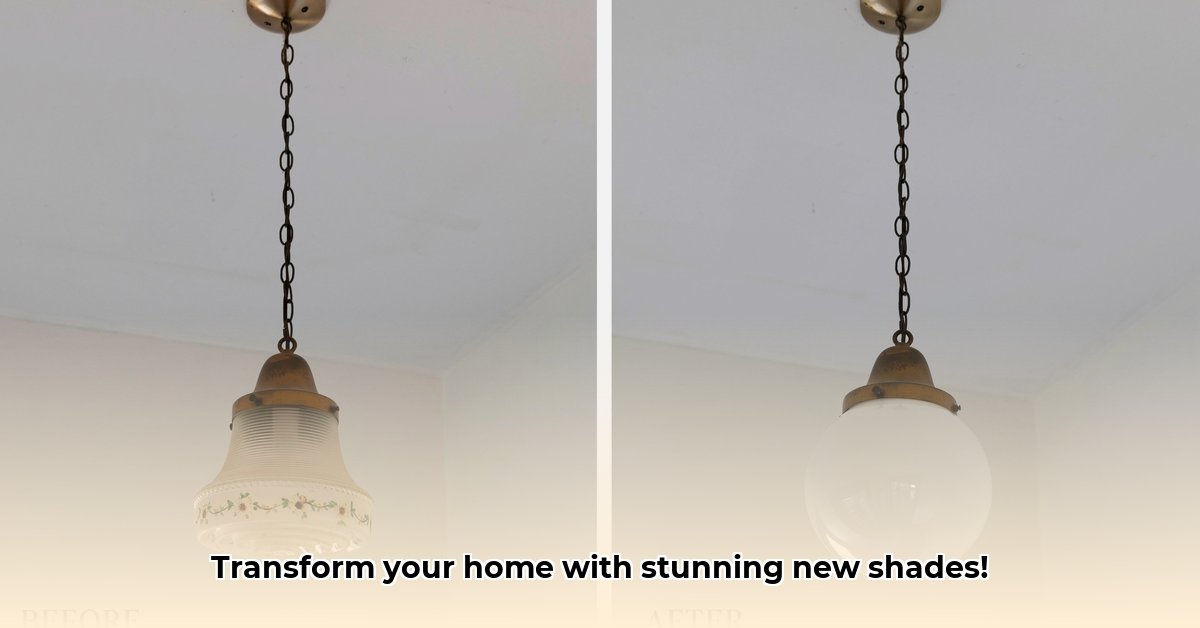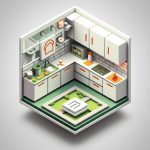Want to refresh your home’s lighting without a major renovation? Replacing light fixture shades offers a surprisingly simple and budget-friendly way to elevate your space. This comprehensive guide provides the essential knowledge, from selecting the ideal style, material, and fitter type to a detailed installation process, making it a smooth DIY project. We will explore the latest design trends, guide you toward the right shade for your space, offer tips for matching shades to your existing décor, and highlight cost-saving strategies. For a wide selection of replacement shades, check out this helpful resource. Prepare to brighten your home with affordable and stylish lighting upgrades!
Replacement Glass Shades: Transform with New Lighting
Ready for a new lighting look without hiring an electrician? Replacing your light fixture shades is an easy do-it-yourself project that creates a significant impact. Let’s discover how to bring new light and style into your home, one shade at a time.
Understanding Your Existing Fixture
Before you start shopping, carefully assessing your current light fixture is key to ensuring a seamless replacement process.
- Fixture Type: Is it a pendant light hanging from the ceiling, part of a multi-bulb chandelier, a sconce mounted on the wall, or a table lamp sitting on a surface?
- Measurements: Use a tape measure to record the height, diameter (at both the top and bottom, if applicable), and any other relevant dimensions of your existing shade. Knowing these measurements will drastically narrow down your search and prevent ordering shades that are the wrong size.
- Socket/Fitter Type: Identifying the socket type – standard screw-in, clip-on, or specialized fitter – is crucial. A “fitter” is the component that connects the shade to the light fixture. Common fitter types include:
- Spider: A metal frame with arms that attach to the bulb base with a screw-on finial.
- Uno: The shade screws directly onto the lamp socket, often used for smaller shades.
- Clip-on: The shade clips directly onto the light bulb, common for candelabra-style bulbs.
- Sketch it Out: A quick sketch of your existing fixture and shade, including dimensions and how the shade attaches, can be very helpful when browsing online or in stores.
Exploring Diverse Shade Styles and Materials
The design possibilities are truly endless when it comes to replacement glass shades! To make the best selection for your space, consider these aspects:
- Glass Variety:
- Clear Glass: Maximizes brightness and allows the light bulb to be fully visible. Best for task lighting or showcasing decorative bulbs.
- Frosted Glass: Provides a softer, diffused light, reducing glare and creating a more ambient atmosphere. Ideal for bedrooms or living rooms.
- Colored Glass: Can dramatically change the room’s vibe, casting a colored glow. Consider the existing color palette of your room and choose a color that complements or accents it.
- Textured Glass: Adds visual interest and dimension, creating unique patterns of light and shadow. Options include ribbed, hammered, seeded, and more.
- Opal Glass: A milky, opaque glass that provides a soft, even light distribution, often used in bathroom vanity lights.
- Style Range:
- Modern: Characterized by clean lines, geometric shapes, and minimalist designs. Often features clear or frosted glass in simple shapes like globes or cylinders.
- Rustic: Emphasizes natural materials, textures, and a warm, inviting feel. May include seeded glass, textured glass, or shades with a slightly distressed finish.
- Industrial: Inspired by factories and warehouses, often featuring exposed hardware, metal accents, and clear glass to showcase the bulb.
- Farmhouse: Combines rustic charm with a touch of elegance, often incorporating elements like seeded glass, milk glass, or shades with a vintage-inspired shape.
- Tiffany-Style: Features intricate stained-glass designs with vibrant colors and patterns, creating a focal point in the room.
- Inspiration: Use online resources like Pinterest, Houzz, and decor magazines for inspiration. Save your favorite images for comparison and to help you visualize how different shades will look in your space.
Smart Shopping Guide for Light Fixtures
Online shopping offers unparalleled convenience and a vast selection when it comes to replacement glass shades.
Smart Shopping Tips:
- Measure Precisely: Double-check all dimensions to ensure a proper fit; even small differences can matter. Pay close attention to the fitter size and type.
- Review Customer Feedback: Read reviews about both the shades themselves and the retailers selling them to avoid potential issues with quality, shipping, or customer service.
- Compare Costs: Prices for similar shades can differ significantly across retailers. Compare prices, factor in shipping costs, and consider checking used marketplaces or antique stores for unique styles at a great value.
- Check Return Policies: Ensure the retailer has a clear and reasonable return policy in case the shade arrives damaged or doesn’t meet your expectations.
- Consider the Bulb: Think about the type of light bulb you’ll be using with the new shade. Some shades are better suited for specific bulb types (LED, incandescent, Edison, etc.) in terms of heat dissipation and light diffusion.
Easy Step-by-Step Shade Installation
Installation is generally straightforward, but safety should always be your top priority.
Installation Steps:
Step 1: Safety First: Always switch off the power at the breaker box that controls the light fixture before starting any work. This prevents electric shock.
Step 2: Remove the Old Shade: Carefully remove the old shade, noting how it was attached to the fixture. Take photos if needed to remember the assembly.
Step 3: Clean the Fixture Base: Use a soft cloth to clean the fixture base and remove any dust or debris.
Step 4: Attach the New Shade: Attach the new shade, carefully following the manufacturer’s instructions. Ensure the shade is securely fastened and properly aligned.
Step 5: Restore Power and Enjoy: Restore power at the breaker box and enjoy your upgraded lighting!
FAQs About Replacing Light Shades
- Q: Can all shades fit any fixture? A: No, the fitter type and size must match your fixture’s socket or mounting mechanism.
- Q: What if I can’t find an exact match for my old shade? A: Similar styles can often work well, especially if you focus on matching the fitter type and size. A slightly different shape or color can still significantly improve the overall look of your lighting. Consult with a lighting specialist for assistance.
- Q: How do I clean glass shades? A: Use a soft cloth and mild soap to gently clean the glass. Avoid harsh chemicals or abrasive cleaners, as they can damage the glass finish. For stubborn stains, try a solution of vinegar and water.
- Q: Where can I dispose of my old glass shade? A: Check with your local recycling center to see if they accept glass for recycling. If not, wrap the shade carefully in newspaper or bubble wrap and dispose of it in your regular trash.
Replacing glass shades is a simple and affordable way to transform your home’s lighting and update your décor. With careful planning, attention to detail, and a few basic tools, you can create a more inviting, stylish, and personalized atmosphere in any room. Upgrade your lighting and brighten your home today!
Selecting Sustainable Glass Shades for Lamps in an Environmentally Conscious Way
Key Takeaways:
- Accurate measurements are essential for a successful replacement and to avoid frustration.
- Carefully consider the lamp’s fitter type: spider, uno, clip-on, or other.
- The materials used significantly affect both light diffusion and the overall style; prioritize recycled or sustainable options to minimize your environmental impact.
- Finding replacements for older, vintage, or antique lamps can be challenging; specialized retailers or antique shops can often provide assistance.
- Choosing sustainable replacement glass shades for lamps involves carefully balancing aesthetic preferences with environmental responsibility.
Measuring Your Existing Lampshade
Before you start browsing online or visiting stores, accurate measurement is absolutely key for ensuring a perfect fit and avoiding the hassle of returns. You’ll need to determine:
- Top Diameter: The width of the lampshade opening at the top.
- Bottom Diameter: The width of the lampshade opening at the bottom.
- Slant Height: The distance from the top edge of the lampshade to the bottom edge, measured along the side.
- Fitter Type: As mentioned earlier, identifying your lamp’s fitter type (spider, uno, clip-on, etc.) is crucial for compatibility.
Eco-Friendly Sustainable Material Exploration
The material you choose for your replacement glass shade has a significant impact on the overall look and feel of your lamp, as well as its environmental footprint. Consider these options:
- Recycled Glass: Opting for recycled glass shades is an excellent way to reduce waste and support sustainable manufacturing practices. These shades are often just as durable and beautiful as those made from new glass.
- Other Sustainable Materials: While this section focuses on glass shades, consider exploring alternatives made from other eco-friendly materials, such as bamboo, recycled fabrics, or even paper.
- Vintage or Upcycled Shades: Shopping for vintage or upcycled lampshades is a great way to give a new life to existing materials and reduce the demand for new production.
Finding the Right
- Glass Backsplash: Ideas For a Stylish Kitchen Update - December 2, 2025
- Glass On Tile: A Stylish Kitchen Backsplash Option - December 1, 2025
- Glass Tiles for Kitchen: Style and Durability Tips - November 30, 2025










